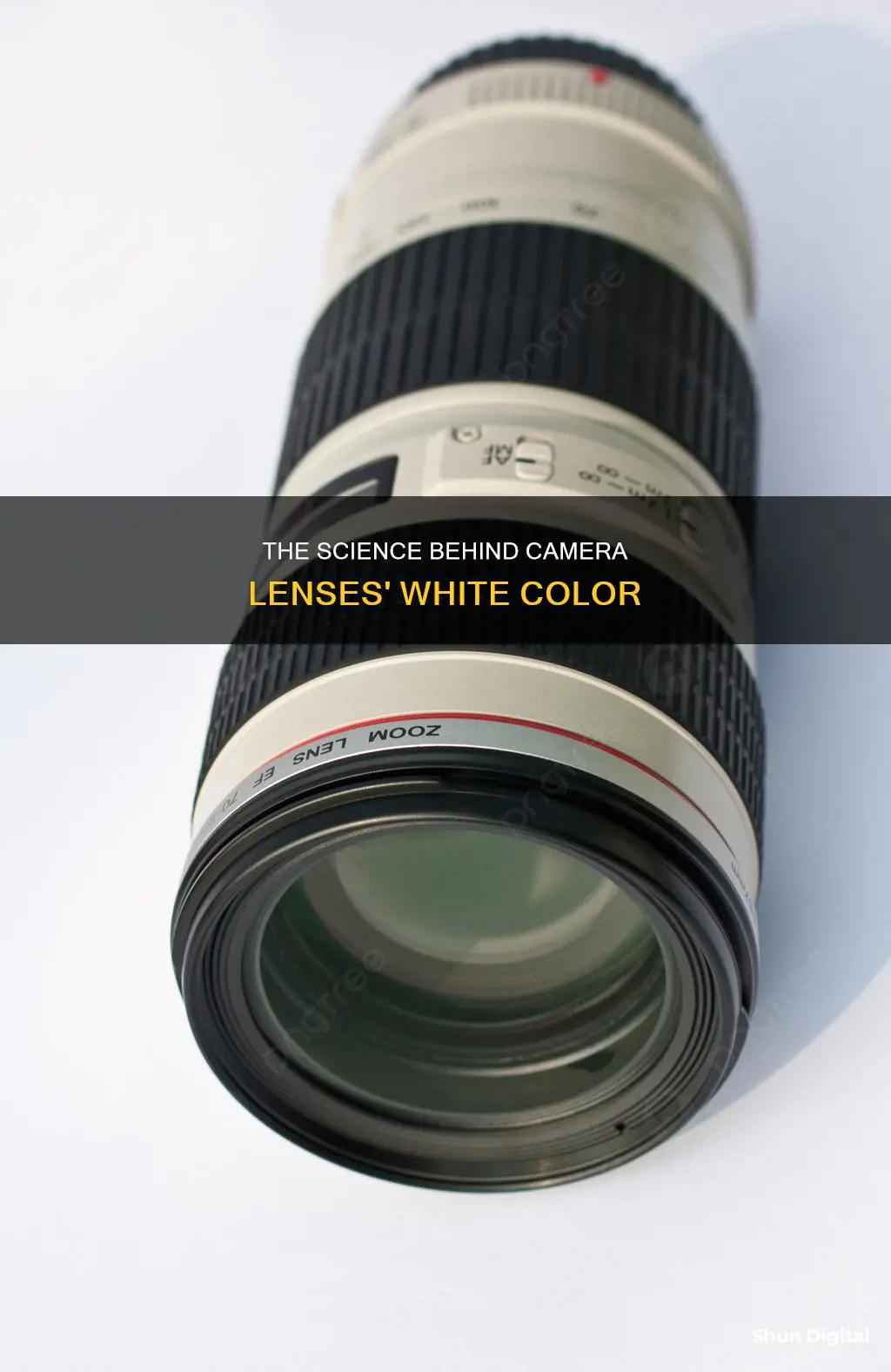
Some camera lenses are white to reflect sunlight and reduce heat. Lenses contain glass elements that expand with heat, which can bring the lens close to the limits of its design tolerances. A white lens reflects sunlight, helping to keep the lens cooler. This is particularly useful for photographers shooting under the sun for long periods, such as sports and wildlife photographers. Canon's white lenses, for example, are well-known for this reason, with the colour also becoming a distinctive part of the brand's identity.
| Characteristics | Values |
|---|---|
| Reason for white colour | Heat reduction |
| Colour | Off-white, putty, light grey, or beige |
| Reflects sunlight | Yes |
| Marketing feature | Yes |
| Branding | Yes |
| Other companies with white lenses | Sony, Pentax, Nikon, Sigma |
What You'll Learn

Heat reduction
Camera lenses, especially telephoto lenses, are often large and contain glass elements. These glass elements are susceptible to heat expansion, which can bring the lens close to its design limits and negatively impact the resulting photo. Heat can also make it burdensome for photographers to hold the lens for long periods.
To mitigate this issue, Canon introduced white lenses, which are more effective at reflecting heat than black lenses. The specific shade of off-white was chosen to reduce light reflection, preventing interference with other photographers' shots. Canon's white lenses first appeared in 1976 on the FD 600mm f/4.5 and FD 800mm f/5.6 models.
Over time, the white colour became a distinctive feature of Canon's L series lenses, making them easily recognisable at major sporting events. This unique colour choice also served as a brilliant marketing strategy, with some photographers even converting their black lenses to white ones to deal with heat.
Other manufacturers, such as Sony and Pentax, have also produced white lenses, particularly for their larger models. However, black remains the standard colour for most DSLR cameras and lenses as it is less noticeable under typical lighting conditions.
Drying Camera Lenses: Quick and Easy Steps for Photographers
You may want to see also

Branding
The white colour of camera lenses is a distinctive feature that has become synonymous with Canon's L-series lenses, particularly in the context of major sporting events. The white finish is more than just a design choice or a branding strategy; it serves a functional purpose related to heat management.
Canon's decision to use a white coating on its lenses is primarily driven by the need to reflect sunlight and reduce heat absorption. This is especially important for large telephoto lenses used in outdoor settings, where they are exposed to direct sunlight for extended periods. The white colour helps keep the lens cooler by reflecting sunlight, preventing overheating and maintaining optimal performance.
Over time, the white colour of Canon's lenses has indeed become a powerful branding tool. The distinctive white lenses have become instantly recognisable, conveying a sense of professionalism and high performance. They stand out in a crowd of photographers, signalling to others that the user is equipped with high-end, specialised gear. This visual distinction has become a trademark of Canon's professional line, enhancing its brand identity and differentiation in the market.
While heat management is the primary reason for the white colour, Canon has also carefully considered the specific shade of white used. Recognising that pure white could reflect light too harshly, interfering with other photographers' shots, Canon opted for an off-white shade. This subtle tweak ensures that the lenses reflect light less intensely while still providing effective heat reduction.
The white colour of Canon's lenses, therefore, serves both functional and branding purposes. It addresses the technical challenge of heat management while also establishing a strong visual identity for the company's professional-grade equipment. This dual purpose has contributed to the iconic status of Canon's white lenses in the world of photography.
Unlocking the Power of Macro Camera Lenses
You may want to see also

Fluorite elements
Canon's white telephoto lenses are well-known and easily recognisable. The white colour is not just for aesthetic purposes or branding, although these are important factors too. The white coating is designed to reflect heat, keeping the lens cooler and reducing the risk of warping from heat exposure. This is particularly important for large lenses with large glass elements, as they can expand with heat and cause issues with the lens's design tolerances. The white colour is also chosen because it is less reflective than pure white, reducing the risk of interfering with other photographers' shots.
Fluorite is a crystallised form of calcium fluoride, which can be used in camera lenses to reduce chromatic aberration. This is a type of lens distortion that causes objects to appear blurry or out of focus. It occurs because different colours of light are refracted at different angles, causing each colour to converge at a different focal point. Fluorite has a low dispersion, meaning it does not refract different colours of light at different angles, and can therefore reduce chromatic aberration. It also has a high refractive index, allowing for the creation of more compact and lightweight lenses.
Fluorite is a valuable material for use in camera lenses due to its low dispersion, high transmission, and high refractive index. It produces sharper, higher-contrast images with less chromatic aberration than traditional glass lenses. It also has a wider spectral range, transmitting light well across a wider range of wavelengths, making it suitable for ultraviolet and infrared photography. Additionally, fluorite is lighter than glass, which can be advantageous for large lenses.
Canon has been using fluorite in its lenses since 1969, when it released the world's first consumer telephoto lens to employ fluorite lens elements. The company has developed its own technology to form large, high-purity artificial fluorite crystals, as natural fluorite is only suitable for use in small optical equipment. Canon's fluorite lens elements incorporate natural fluorite as a raw material, giving the lenses low-refractive and low-dispersion properties that cannot be achieved with glass lenses.
APS-C Lenses: Universal Fit for All Cameras?
You may want to see also

Lens size
The size of a camera lens, or more specifically, its focal length, is one of the most important things to consider when choosing a lens. Focal length is measured in millimetres and can be found in the lens' specifications, as well as being printed on the front of the lens.
Focal length determines the angle of view and how much the subject will be magnified from a given photographic position. A low focal length is more zoomed out, while a higher focal length is more zoomed in.
Lenses can be split into two types: zoom lenses and prime lenses. Zoom lenses allow the photographer to vary the focal length within a predefined range, while prime lenses have a fixed focal length. Zoom lenses are more versatile and are perfect for fast-paced shoots, as they allow for variation without having to carry and change multiple lenses. Prime lenses, on the other hand, are smaller, cheaper, and have a greater maximum aperture. They are also able to produce higher-quality images than zoom lenses.
Zoom Lenses
Zoom lenses are incredibly versatile and are one of the most common types of lenses. The most popular zoom lens is the 70-200mm lens, often used by wedding photographers. For travelling light, a zoom lens with a much wider range, such as an 18-270mm, can be used to photograph both close-up and in the distance.
Standard zoom lenses sit between 24mm and 105mm, offering more focal length variation, but not as much speed as a 24-75mm zoom lens.
Prime Lenses
The 50mm prime lens, otherwise known as the "Nifty Fifty", is perfect for portraits as the focal length is seen to be as close to the human eye as possible. A 35mm prime lens, on the other hand, is usually best for landscape photographers.
Telephoto Lenses
Telephoto lenses are another type of lens with longer focal lengths, resulting in a narrow field of view, low depth of field, and a magnified image. They are often used in sports and wildlife photography, as they can capture the slightest movements from long range.
Telephoto lenses typically fall within the following ranges: 70-200mm, 100-400mm, and 150-600mm. Any telephoto lens above 400mm is called a "super-telephoto" lens and can cost upwards of $20,000.
Wide-Angle Lenses
Wide-angle lenses have a wider field of view and a shorter focal length. They are often used for landscape photography as they can capture more of the scenery, creating a vivid picture. They are also good for photographing architecture, as the whole building can be captured in the frame.
Standard "wide-angle" lenses have a focal length between 35mm and 24mm. Anything below 18mm is considered ultra-wide-angle and would produce a fisheye effect.
Other Types of Lenses
There are several other types of lenses available, including:
- Macro lenses: Allow for extreme close-up focus, often used for photographing plants, insects, and jewellery.
- Rectilinear lenses: Help to keep straight lines straight and are used for realistic, well-composed shots.
- Fisheye lenses: Provide an ultra-wide, curvilinear view, distorting the image to create a stylised, panoramic picture.
- Tilt-shift lenses: Allow photographers to play with perspective, distortion, and depth of field, all by tilting the lens.
Cracking Camera Lenses: A Step-by-Step Guide to Mastery
You may want to see also

Marketing
Canon's white lenses are a distinctive feature of the brand, and the company has leveraged this colour for marketing purposes. The white lenses stand out at major events, such as sports games and the Olympics, making it easy to identify Canon users, even from a distance. This has become a powerful marketing strategy, with the white lenses now synonymous with Canon and its high-end products.
The white colour of Canon's lenses is not just a marketing tactic, however. It also serves a technical purpose, helping to reduce heat absorption when photographers are working outside under the sun for extended periods. Canon's lenses contain glass elements that expand with heat, and the white coating reflects sunlight, keeping the lenses cooler. This helps to prevent warping of the lens components, which can negatively affect the resulting photo.
Canon's choice of white also helps photographers by reducing the burden of holding a hot lens and improving comfort during long shoots. The colour white is known for its resistance to absorbing light and, by extension, heat. Canon's off-white shade is slightly softer than pure white, reducing its reflectiveness to prevent interference with other photographers' shots.
The white colour of Canon's lenses has become an iconic part of the brand's identity, with a history spanning over 50 years. It is a unique feature that sets Canon apart from its competitors and has become a recognisable signature of the brand, especially at major events.
Adapting EF Lenses to Mirrorless Cameras: A Guide
You may want to see also
Frequently asked questions
Camera lenses are white to reflect sunlight and reduce heat.
Lenses contain glass elements that expand with heat, which can bring a lens close to the limits of its design tolerances.
No, heat reduction is more important for larger lenses, as the difference in heat absorption is proportional to surface area.
Yes, white lenses are also good for marketing and branding purposes, as they stand out in a crowd.
Canon's professional L series lenses are white, as well as some lenses from Sony and Pentax.







